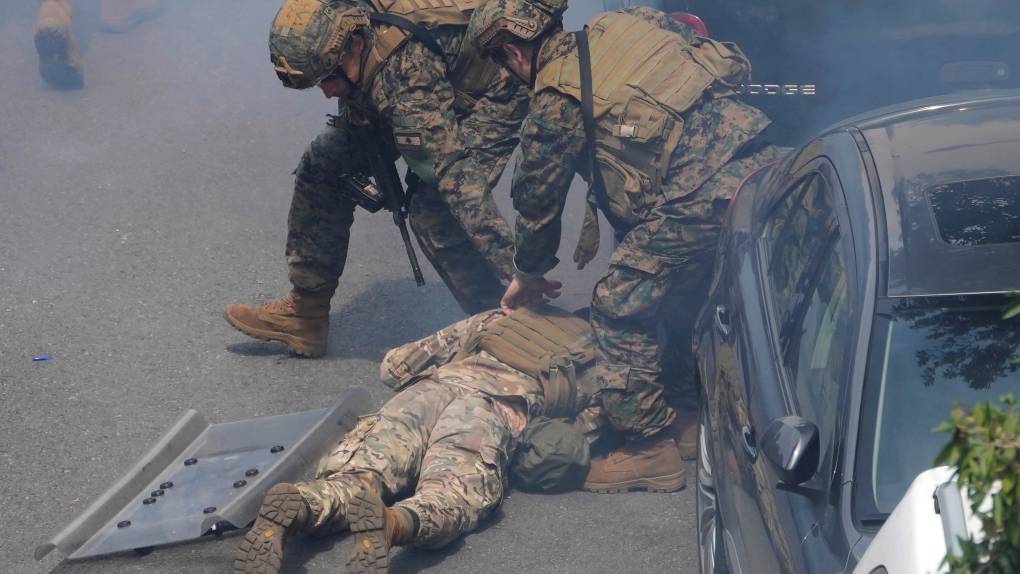SALEM, Ore. -
More than 119,000 people have been injured by tear gas and other chemical irritants around the world since 2015 and some 2,000 suffered injuries from "less lethal" impact projectiles, according to a report released Wednesday.
The study by Physicians for Human Rights and the International Network of Civil Liberties Organizations, in collaboration with the Omega Research Foundation, took 2 1/2 years to research. It provides a rare partial count of casualties, compiled from medical literature, from these devices used by police around the world, including in Colombia, Chile, Hong Kong, Turkiye and at Black Lives Matter protests in the United States.
The vast majority of the data comes from cases in which a person came to an emergency room with injuries from crowd control weapons and the attending doctor or hospital staff made the effort to document it, said the report's lead author, Rohini Haar, an emergency room physician and researcher at the University of California School of Public Health in Berkeley.
The report on casualties from a largely unregulated industry cites an alarming evolution of crowd-control devices into more powerful and indiscriminate designs and deployment, including dropping tear gas from drones.
It calls for bans of rubber bullets and of multi-projectile devices in all crowd-control settings and tighter restrictions on weapons that may be used indiscriminately, such as tear gas, acoustic weapons and water cannons, which in some cases have been loaded with dyes and chemical irritants.
U.S. Sen. Ron Wyden, a Democrat from Oregon, said the report underscores serious issues.
"These troubling global numbers echo the concerns I raised locally when Donald Trump first dispatched armed troops to Portland in 2020 with no guidance on their use of chemical munitions near schools and against protesters when most were peacefully exercising their First Amendment rights," Wyden said. "The report's recommendations are very worthy of consideration by the Department of Homeland Security."
Portland, Ore., was an epicentre of racial justice protests after the killing of George Floyd by Minneapolis police in May 2020. Police and protesters clashed, with officers firing tear gas, pepper spray and other devices, turning parts of the city into battle grounds.
Then-President Trump sent militarized federal agents to protect federal property and the violence escalated, with officers beating protesters with batons and dousing the crowds with tear gas and other irritants. Bystanders and nearby residents choked on the fumes, their eyes watering and burning.
Portland Police Bureau spokesperson Terri Wallo Strauss noted that the department's updated policy emphasizes "the goal of avoiding the use of force, when feasible."
Police say crowd-control devices are, if used properly, an effective tool for dispersing rioters.
"Rallies basically spin out of control when they've been hijacked by individuals that have come in with a nefarious purpose to create the riots, the looting, those type of things. And then, obviously, law enforcement has to come in and try their best to create a safe resolution and try to restore order," Park City, Utah, Police Chief Wade Carpenter said during the height of the Black Lives Matter protests.
Carpenter is also an official with the International Association of Chiefs of Police, which has more than 32,000 members in more than 170 countries. The group declined to comment on the new report. But in 2019, it recommended guidelines on crowd management.
Pepper spray, or oleoresin capsicum, may be used against "specific individuals engaged in unlawful conduct or actively resisting arrest, or as necessary in a defensive capacity," the guidelines state. "OC spray shall not be used indiscriminately against groups of people where bystanders would be unreasonably affected, or against passively resistant individuals."
But the internet is full of instances in which pepper spray was used against non-resisting people, including against Tyre Nichols, who was beaten to death by Memphis police in January.
Tear gas "may be deployed defensively to prevent injury when lesser force options are either not available or would likely be ineffective," the IACP guidance states. Projectiles that are supposed to hit a surface like a street before impacting a person "may be used in civil disturbances where life is in immediate jeopardy or the need to use the devices outweighs the potential risks involved."
Direct-fired impact munitions, including beanbag rounds, "may be used during civil disturbances against specific individuals who are engaged in conduct that poses an immediate threat of death or serious injury," the guidance says. Protesters have been blinded and suffered brain damage from beanbag rounds.
Numerous lawsuits have been filed over use of force by police during protests.
In November, the city of Portland reached a $250,000 settlement with five demonstrators in a federal lawsuit over police use of tear gas and other crowd-control devices during racial justice protests.
But last month, a federal judge threw out an excessive force claim against an unnamed federal agent who fired an impact munition at the forehead of protester Donavan La Bella, fracturing his skull, as he held up a music speaker during a racial justice demonstration in Portland in 2020. La Bella continues to struggle with a severe head injury.
Haar, who is a medical adviser for Physicians for Human Rights, said the number of injured is far greater than what she compiled from medical reports.
"Basically, we knew we're capturing sort of the tip of the iceberg," she said. "This is just a tiny fraction of what the world is experiencing on a daily basis. The vast majority of injuries -- even significant severe injuries -- go unreported."
------
Associated Press writer Larry Neumeister in New York contributed to this report.












































